Pros: detailed, revealing, outstanding depth and instrument separation, punchy engaging listen, speedy like a coked up F1 driver
Cons: compact soundstage for a flagship (small width/height), poor accessories, long-term comfort, listening fatigue, $$$$, sensitive to accessory cables (you’ll probably buy at least one)
List Price: £3499 (UK, Audio Sanctuary), $4000 globally
Product Website: https://www.focal.com/uk/headphones/home/utopia
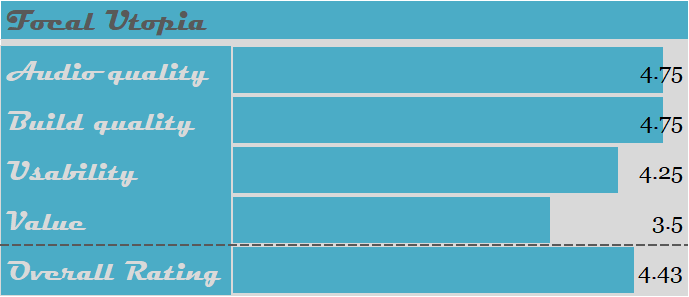
Rating Disclaimer: ratings are subjective. Audio quality and value do not mean the same thing across all prices. A headphone with a 5 rating on audio at $5 does not have equivalent sound quality as a 5 rating at $500. Likewise, value at $5 is not the same as value at $5000 dollars.
Introduction
The Focal Utopia is widely regarded as one of the best headphones on the planet for technical capability and sound quality. I’ve reviewed what I believe is the best headphone on the planet under $50k, the HiFiMAN Susvara, but I hadn’t spent any time outside of shows listening to the Focal Utopia. At shows, I’d found that I didn’t like it out of everything I listening to. I thought it paired well with the Naim amp I first heard it on, and badly with the Dragon Inspire IHA-1 tube headphone amp. Next time I heard it, it was another Naim amp, and it sounded different once again, with north of neutral bass and a bit of lift in the lower treble.
I’ve got a good relationship with SCV distribution, so I was able to get a loan of the Focal Utopia for some time.
Useability: Form & Function
Unboxing
 The box looks fancy, nice leather display box with excellent padding throughout and compartments for each component, but no case, and only one Manute Bol (he was 7’7″) sized cable. Where is all the good stuff that comes with the Clear? I’m of the opinion that after releasing the Clear with a travel case, one normal sized cable, and two over-sized cables (including a balanced cable), all the other Focal headphones should have immediately got the same treatment, but this did not happen. The $1500 Focal Clear has better accessories than $4000 Utopia. Fix it Focal.
The box looks fancy, nice leather display box with excellent padding throughout and compartments for each component, but no case, and only one Manute Bol (he was 7’7″) sized cable. Where is all the good stuff that comes with the Clear? I’m of the opinion that after releasing the Clear with a travel case, one normal sized cable, and two over-sized cables (including a balanced cable), all the other Focal headphones should have immediately got the same treatment, but this did not happen. The $1500 Focal Clear has better accessories than $4000 Utopia. Fix it Focal.
Again, the presentation and packaging are excellent, but the functionality of what’s in the box is kind of nonsense. The included cable is 3 meters long. Did they actually talk to headphone users, or did they just assume that the Utopia would be used in the same position as their 2 channel speakers (which are really nice by the way)? Focal went to the trouble of making it so the Utopia can be adequately powered off most decently endowed DAPs, but then they didn’t include a 3.5mm terminated cable or for that matter a cable made for humans. I’m imagining Wun Wun wearing this cable and thinking it’s perfect length and girth (expressed as a deep rumble). There is also not a balanced cable included. Sometimes, it’s the little things that kill.

More unboxing pictures can be found here.
Build, Aesthetics and ergonomics
The cable is a good thickness cable with excellent conductors and it is built balanced, just without a balanced amp connection (why!?). It’s a high quality cable, just not pitched to the audience this headphone is really for: headphone audiophiles. I don’t think that the Utopia is really pitched for music producers, and balanced connectors are basically ubiquitous in top tier cans for audiophiles. I kind of understand why they don’t have two cables with the Utopia, Lemo connectors are expensive ($70 to add them to a Double Helix Cable Prion 4). Lemo connectors are of extremely good build quality, there’s a reason why the connectors cost so darn much. They have well-built moving parts and are basically impossible to remove without intent. Lemo connectors are sturdy with a very secure and a good contact surface area.
The Focal Utopia comes in all the colours you want if you want black, but it is stylishly done, with nice silver accents on several nicely placed bevelled edges, steel screws holding the carbon fibre gimbals to the drivers, and a precision stamped silver grille exposing the eye of the beast—the driver looks like a beast eye looking out at you with a grey centre and red spider for the 40mm solid beryllium driver. The pads are made with a high quality leather with perforations for ventilation and sound tuning. The cups have a small pivot built into the headband (probably 20⁰ front and back). I found this pivot inadequate to get the full surface of the cups flush with my head. The head pad is also perforated and nicely cushioned. The left and right side of the headphones are labelled on the headband, and there are faint labels by the Lemo jack plugs. I would have used the red ring that others use to denote right. Much of the cup assembly is made of high quality plastic, which is probably necessary due to the weight of the magnets in these.
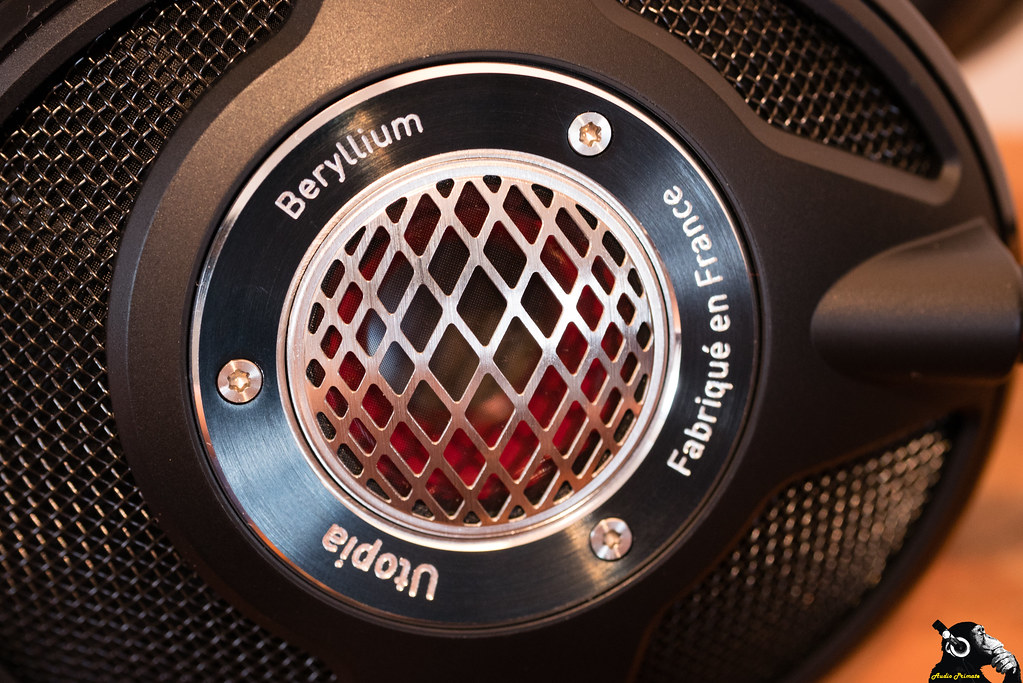
I found the Utopia to cause pressure points on my jaw where the clamp force is focused due to my inability to get the cups to sit completely flush due to the limited range on the cup swivelling. I can’t just put the headphones on and forget about them like the HiFiMAN HE-1000 v2, HiFiMAN Susvara, or the Sennheiser HD600. These are comfortable enough for a normal listening session (couple hours), but we are audiophiles, we aren’t normal. We listen for stupid lengths of time. I’m on hour 5 at 2AM as I write this.

Audio quality
The desktop setup:
- Dell Inspiron running JRiver (source)
- Vertere Acoustics D-Fi DD 2 wire USB cable (split power and signal)
- iFi Micro iUSB3.0
- LH Labs Lightspeed 2G (split power and signal)
- Questyle CMA600i or Aune S6
- Vertere Acoustics D-Fi XLR to RCA interconnect
- XIAUDIO Formula S (Eleven Audio) or Aune S6 (no interconnect) or Questyle CMA600i (no interconnect)
- Headphone cables: all Atlas Zeno.
I started my listening using the Wire-on-Wire Experience 680 RCA interconnects and switched to the Vertere Acoustics DFi after I was noting a hardness in the upper mids/lower treble of the Utopia. I was getting fatigued quickly. I think the Utopia has a little bit of emphasis in this area, and the added emphasis of the bright Wire-on-Wire cable was too much. The Vertere Acoustics DFi cable is less bright, while still maintaining excellent detail resolution. I could have also tried the Wire-on-Wire spacers (they lower treble output), but I didn’t do that.
For listening with the Focal Utopia low gain was always used. I never had to take the volume past about 30%. The Focal Utopia is easy to drive as flagships go. The HifiMAN cans were played on High Gain (on the Formula S only). As volume matching open cans is hard to do via measurement, I did it by ear. Feel free to take my observations with a grain of salt, but I recommend you try using only an SPL meter to volume match open cans with different dispersion patterns. I think that you’ll probably find that you’d do the same as me.
Amplifier/DAC Pairings
All amplifier pairings were done using the balanced output on each amplifier, except for the Questyle QP2R. The cable used with the Utopia was the Atlas Zeno cable with termination in two 3-pin XLR with a dual 3-pin XLR to 4-pin XLR Vertere Acoustics Pulse HB adaptor, except on the pairing with the Questyle QP2R. Even though the dual 3-pin to 4-pin XLR conversion is unnecessary on the XI Audio Formula S, I maintained this connection for consistency. For the Questyle QP2R pairing, the stock cable was used with a Sennheiser 6.3mm to 3.5mm adaptor. I used white noise to volume match, holding an SPL meter in one hand and the Utopia in the other, being careful to try to replicate microphone position on the SPL meter and grip on the Utopia to try to make the measurements as consistent as possible. Here is the volume match table for all sources, so that you can at least attempt to replicate my observations should you have a similar set-up.
| Source | Gain | Volume | SPL |
| XIAUDIO Formula S | Low | 1/3 | 78.1 |
| Questyle CMA600i | — | 6.75 | 78.2 |
| Aune S6 | — | 59 | 78.3 |
| Questyle CMA600i | — | 8 | 78.2 |
| Questyle QP2R | High | 102 | 78.3 |
Aune S6
Listening to 2Pac – God Bless the Dead, the bass has great richness on the S6. Deep and bold. Nice. The S6 drives the Focal Utopia with plenty of headroom. Compared to the Questyle CMA600i, the stage is more forward with less depth on the S6. The S6 still allows picking apart the image, with the excellent resolution characteristics still showing. The S6 isn’t quite refined enough for the Utopia. The CMA600i is better.
Questyle CMA600i
The mids are a bit clearer on the CMA600i on God Bless the Dead, but the lows don’t have as much body as the S6. On Leonard Cohen – Leaving the Table, the bass has more texture and the separation in the mids is greater with better detail. The CMA600i drives the Utopia effortlessly with great space in the stage. On Outkast – Ms. Jackson, the details pop beautifully on the track with excellent separation in the tightly layered mids. Dog barks, laughing, layered guitars and percussion are all nicely separated. I love the funky bass guitar line here. Instruments have remarkable spacing, better than the S6.
Compared to the XIAUDIO Formula S, the Questyle CMA600i is more forward. Kate Bush’s vocals are thrust upon you in Cloudbusting more than on the XIAUDIO Formula S, where they are a touch further back. Bass is nice and chooglin’ on The Beach Boys – Sloop John B (DSD64). Because the stage depth is less than the XIAUDIO Formula S, the reproduction sounds more forward.
When listening to Why? – Sod in the Seed there is little difference between the presentation of the CMA600i and the QP2R, which leads me to believe that both drive the Utopia equally well.
Questyle QP2R
Why? – Sod in the Seed comes off a bit sharp in the high guitar notes. The detail is spectacular, as with every other pairing. Fleetwood Mac – Dreams has a bit forward sounding cymbals, and the decay is a bit quick, leading to a bit of a tinny sound, this is replicated on the CMA600i in single-ended operation. I think these probably benefit from an upgrade to the included cable, as the Utopia with Atlas Zeno sounded better on the CMA600i.
XIAUDIO Formula S
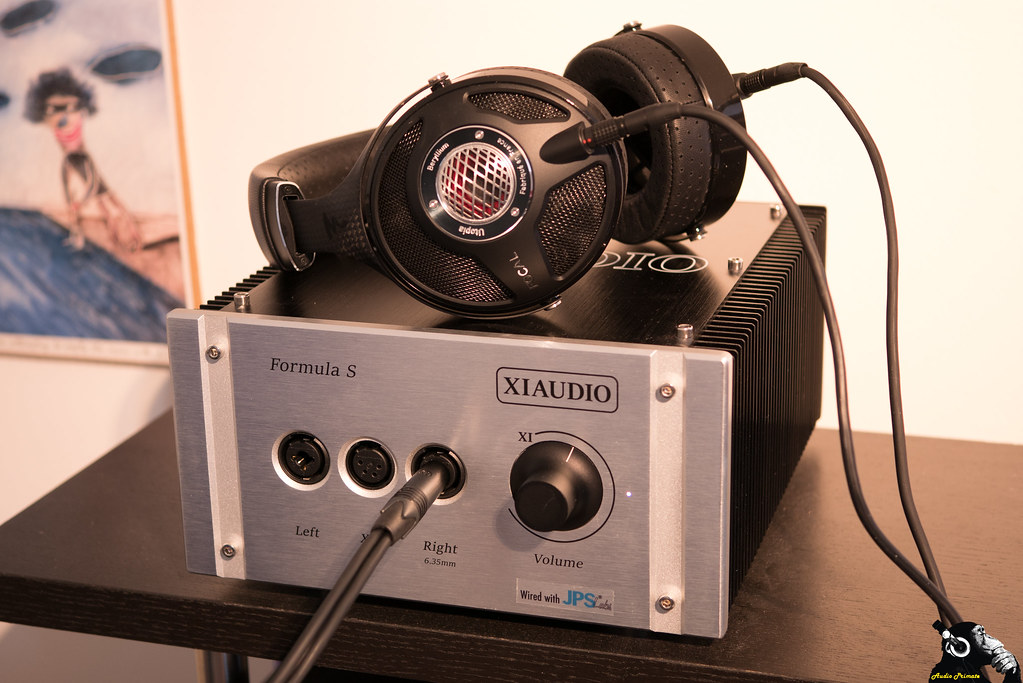
The XIAUDIO Formula S, fed by the Questyle CMA600i as DAC (unity gain), is smoother and less punchy than the CMA600i as the DAC and amplifier. Stage depth is a bit greater on the XIAUDIO Formula S. The stage width is also greater on the XIAUDIO Formula S compared to the CMA600i when listening to Kate Bush – Cloudbusting. Likewise, the stage width and separation are more impressive on the XIAUDIO Formula S. Tonally both the Formula S and CMA600i produce a similar presentation. I think the difference are primarily due to better stage performance on the Formula S, though if I had to state any tonal difference I would say that the sound is more forward on the CMA600i. Rush – The Spirit of the Radio further highlights the differences in stage depth between the two amplifiers. Neil Peart’s drum kit is further back in the stage with much more separation from Geddy Lee’s vocals and the ambuscade of drums has more resolution and spacing. On the Pixies – Where Is My Mind, the stage is bigger and more clearly defined on the Formula S than the CMA600i. The observation was replicated when listening to Fleetwood Mac’s Rumours album. The Utopia does benefit from a better amp, in spite of not being incredibly demanding as flagships go.
Headphone Comparisons
All headphone comparisons were done on the Formula S using Atlas Zeno cables. The Focal Utopia was hooked up with dual 3-pin XLRs (appeared to be silver pins). The HiFiMAN HE-1000 v2 and the HiFiMAN Susvara were connected via 4-pin XLR (brass pins). It would have been nice to have the same connector, but you work with what you got. Thanks for the loaner cables SCV and Atlas Cables.
HiFiMAN HE-1000 v2
First up, some non-sonic stuff. The HE-1000 v2 are way more comfortable than the Utopia. The larger swivel radius of the cups on the HE-1000 v2 means there are no pressure points, the cups sit flush even pressure distribution. The larger pad surface area and grill surface area also means that weight and heat are better distributed. The HE-1000 v2 are lighter, with a better distributed load due to the design of the strap. They don’t look as tough or prestigious as the Utopias, but they are more functionally minded in their design.
Overall sound impressions. The HiFiMAN HE-1000 v2 is smoother and more natural sounding than the Utopia. It has a more open sound with a wider and taller soundstage. It has a very real feeling. The Utopia has a deeper soundstage than the HE-1000 v2. The small size of the soundstage gives a clear disconnect from the feeling of reality over headphone simulation. The Utopia has a remarkably black background. When listening to the Tom Waits – The One That Got Away the silence between instruments and notes is impressive. So clean and clear. Love the stand-up bass accuracy and separation between the instruments. The whole album has a live feel to it and it’s especially apparent on this track. The HE-1000 v2 has a little lighter touch on the mids. On the Utopia, the decay is stand-up bass is more natural, it’s a touch fast on the HE-1000 v2. Saxophone sounds a little rougher and reedier on the HE-1000 v2, the Utopia is smoother through the mids with a bit more body. There’s a bit more texture in Tom Wait’s voice on the HE-1000 v2.
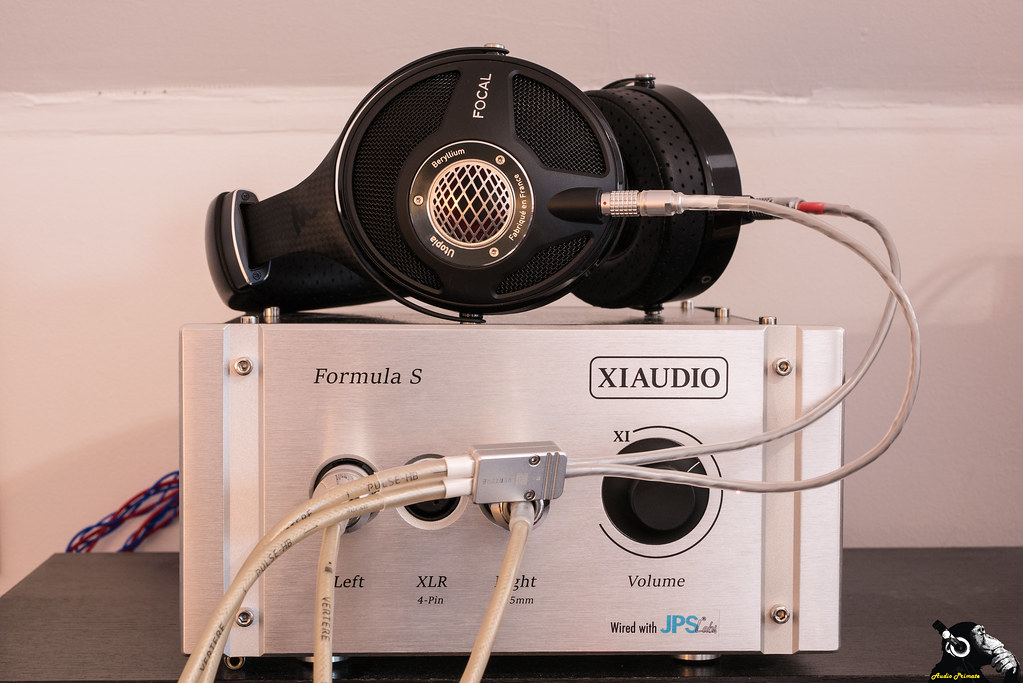
Listening to Slayer – Necrophobic the mids are a bit thicker and less textured on the Utopia. The decreased width of the soundstage reduces the ability to resolve the band in space. With Talking Heads – Psycho Killer the Utopias have a bit of thickness in the vocals that deadens a little bit of the dynamics in David Byrne’s voice. The HE-1000 v2 are more natural and timbrally accurate. They also have a wide stage.
Listening to Shostakovich Symphony No. 1, the Utopia does a beautiful job of rendering the depth of instrumentation. Instruments are clearly separated in the y-axis (moving from the listener perpendicular to the face), but the width (x-axis) is not sufficient to get a good idea of the scale of the orchestra, the stage height (z-axis) is also not exceptional. The HiFiMAN HE-1000 v2 has better stage dimensions. There is a nice sweetness to the violins. Strings in general sound beautiful with just the right amount of weight given to each part of plucked and struck notes.
Roger Waters’ album Amused to Death is one of my all-time favourite albums for sound quality. When listening to the album I found that the 40mm dynamic driver gave my ears a pretty good thrashing at similar volume to comfortable listening on the HE-1000 v2. I think that because the driver area disperses the sound more on the HE-1000 v2 that there is less pressure on any given area of the ear, while the Utopia is a piston driving pressure directly at my ear-drum. The HE-1000 v2 also imparts more breathiness into Roger Waters – Three Wishes. However, it should be noted that the Utopia sounds more impactful on Three Wishes.
Overall, I think that in most areas, the HE-1000 v2 is more to my liking than the Utopia. It has a bigger stage, it is more comfortable, it causes less listening fatigue. It is also less expensive. Matched with essentially the same aftermarket cable, the Atlas Zeno, the HE-1000 v2 is the better buy at $2999 and, to my ears, the better sounding headphone. Some will prefer the more impactful and intimate sound of the Utopia. Both headphones are very detailed but the HE-1000 v2 sounds more natural to me.
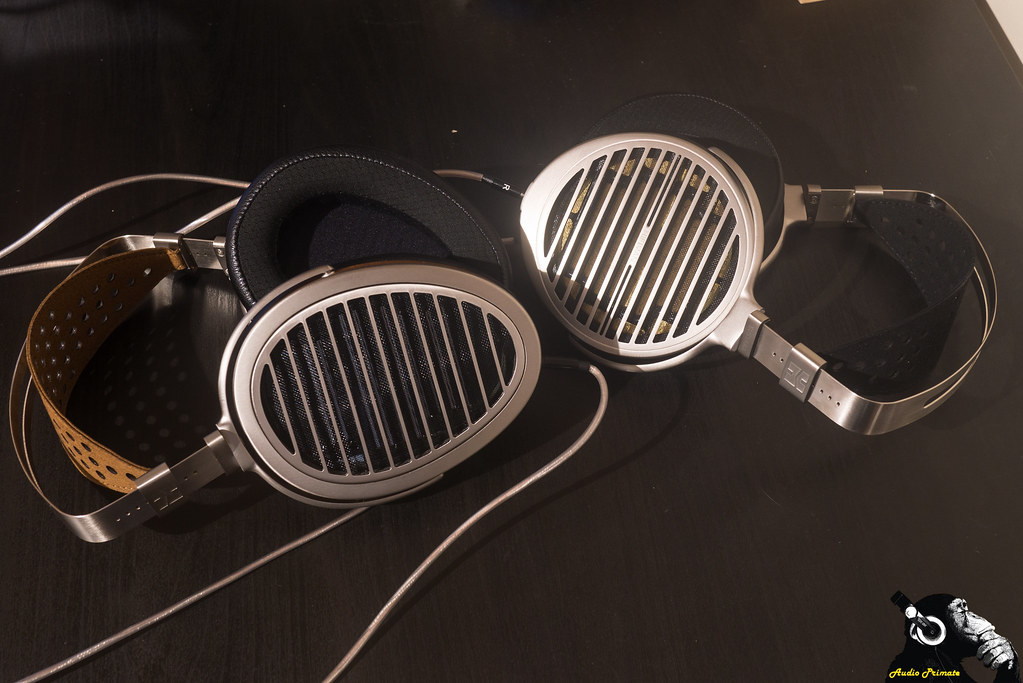
HiFiMAN Susvara
This isn’t likely to go well for the Utopia, as the HE-1000 v2, which isn’t as stellar as the Susvara just beat the Utopia. I’ve given this a couple days rest to wipe clear my memory. The amp is on, warmed up, and my ears are ready to make the attempt at volume matching by ear—I don’t have the set-up to match two different open cans, dispersion differences change measurements.
Listening to Why? – Waterlines the bass is a bit less punchy on the Susvara. The overall ambience of the Susvara is bigger. The harp strings pluck in space with delicious delicacy, whilst wood blocks have a rounder impact, and snare snaps have more air dispersion around them. The opening strings are in a more compact space listening to the Utopia, whilst strings are more enveloping on the Susvara. Tambourines are more present on the Utopia and Yoni Wolf’s vocals are also more forward. Wood block hits are more compact and snappy. Overall the sound is sharper and more compact on the Utopia, and more expansive and inviting on the Susvara.
Stepping into Dave Brubeck – Take Five, the Utopia is tighter with greater impact on drums, but a bit hard sounding compared to the Susvara. The Susvara presents similar detail and shape but the thunderous drum solo in the middle of the track doesn’t have the same violence that the Utopia displays. The Utopia fires off the drum riff like a volley of machine gun fire in a thunderstorm. These are alternative tonal presentations of the same sounds, and both headphones call up the same detail and maintain the same speed. When listening to cymbals the Utopia is a bit more forward with shorter attack and decay. As with the previous track, the stage width and depth are superior on the Susvara.
Diana Krall’s voice smacks with tiny details as her dry mouth draws breath between notes on the Susvara. Little clicks of her tongue percolate to the surface on The Girl In The Other Room. Those same little clicks are there too on the Utopia. The soundstage is smaller and Diana Krall’s voice is more forward on the Utopia. Cymbals on the Susvara sound soft and smooth compared to the Utopia, whilst not being particularly soft. Upper mid and lower treble percussion are more snappy on the Utopia. Both headphones have a realistic feel.
Outkast – Ms. Jackson has some surprisingly complex mixing, and the Utopia does a modestly better job keeping everything in the complex scene organised and clear. The track can get confusing, and the Focal Utopia keeps up a bit better with the dispersed signal.
Bass test time. Kick it Pac. Bass on the Utopia is tight and controlled on Troublesome ’96. Such a groovy bassline. Never gets old, especially when listening on such stellar headphones. The snare drum retains the violence observed on other tracks. There’s a touch more texture in the bass on the Susvara. It’s actually revealing some unpleasant distortion artifacts in the bass. It’s harder to listen to than the Utopia. The bass is cleaner, without distortion showing up as much in the bass on the Utopia. The bass line has more weight. The distortion is still there, but it isn’t as clear on the Utopia. Piano has nice delicacy on the Susvara. On Max Richter – Dream 1 (before the wind blows it all away) the Utopia goes impressively deep and handles the power of the bass piano notes, including the low sub-bass notes with nice gravity. The Susvara is richer with more developed bass texture. It goes just as deep but gives more texture and amplitude in the lower sub-bass while being a bit less impactful in the upper sub-bass. The sub-bass on the Susvara has more rumble than the Utopia. I don’t have measurements, but I would guess that the Susvara has more energy between 10Hz and 40Hz than the Utopia, but the Utopia has more energy between 40Hz and 60Hz. The structure of the bass notes is just a bit different. The Utopia has a more clean and precise sound, while the Susvara is deep with natural sounding linearity. I think while the Susvara has more rumble, the clarity of the Utopia bass puts it on par.
When I reviewed the Susvara, I found that a bright interconnect, the Wire On Wire Experience 680, gave the Susvara that bit more detail throughout the spectrum, but added a touch of fatigue. The Experience 680 made the Utopia sound harder with some tones entering into harsh territory, it was not an ideal pairing. I think that both headphones have quite a bit of potential for synergy with different set-ups. I think if I put the Wire On Wire Experience 680 back in with the Utopia, the distance between the two headphones will be larger as the synergy with the Susvara of the Experience 680 is excellent (and can be tuned to drop out the tiny bit of fatigue on the pairing). As is, with the Vertere Acoustics D-Fi XLR to RCA interconnects they are fairly close. The Vertere Acoustics softens the Utopia somewhat, and I think it is doing the same to the Susvara. When I put the Wire on Wire Experience 680 back in with the Susvara, the Susvara burns up the quarter mile and takes those pink slips. Instrument separation is on par or better, complex passages are handled with the same intricacy as the Utopia. The sound is more natural than the Utopia. The bass detail is substantially better than the Utopia with some serious rumble. The soundstage is still superior on the Susvara.
For long-term listening, the Susvara is more comfortable from an ergonomic and listening fatigue perspective. The more impactful sound of the Utopia, whilst engaging, can also be fatiguing. It will get your toes tapping like mad and your head banging or grooving (as is appropriate to your choice of music), but not for as long as the Susvara. I think the Utopia has a hair more detailed and precise sound, but the Susvara has more linearly extended bass and a significantly larger sound stage. I find the sonic portraiture of the Utopia to be vibrantly engaging, whilst the Susvara is more neutral and absorbing. The Susvara lets you melt into the sound a bit more than the Utopia, which demands your ears stand at attention for the next spat of violence.
Cable Pairings
Headphone cables
The stock cable is a good heavy-duty cable. It’s just too darn long. It has right and left sides, but you’d be forgiven for not knowing as the markers are in faintly imprinted small impressions on the rubber strain relief of the Lemo connectors. There is no colour coding for right and left and no physical cues. Focal clearly didn’t expect that people would disconnect the cable often. That’s actually a pretty reasonable assumption. How reviewers interact with gear is not at all normal.
Cables were volume matched using an SPL meter. Volume matching on the same open headphone between amps and cables is consistent. The amp was the XIAUDIO Formula S. There was no volume difference between the Atlas Zeno (£250-£300, couldn’t find price with Lemo connectors) and the Vertere Acoustics Pulse HB (£1400). Both the Zeno and the Pulse HB used dual 3-pin XLR connectors. The connectors on the Zeno appear to be silver, whilst the Pulse HB uses gold-plated brass.
The switching time was substantial as the Lemo connectors are right bastards to deal with if you want to switch between setups quickly. They need to be flawlessly aligned and they have little spring-loaded rings that are a bit finicky. I didn’t have two Focal Utopias on hand, so I did the best that I could switching between them, but the time lag means that you have to trust my hearing and hearing memory over my process, so take any observations salted to taste.
To be honest, given the cables that I’m working with, I just don’t have confidence that my memory is good enough. I did repeated switches back and forth between the Zeno and the Pulse HB, but my observations were inconsistent, which in the absence of any other evidence is reason to conclude that it is likely that the sonic difference between the cables is either non-existent, or tiny. If I had to say anything about sonic differences with low confidence it would be that the Pulse HB sounds a bit drier.

From a build quality standpoint, both the cables are beefy, with very nice looking build quality. The Pulse HB is a bit tougher looking, and has chunky-super-heavy-why-am-I-so-damned-heavy-because-it-screams-premium XLR connectors. They are stupidly heavy. They do not need to be this heavy. This is silly. The Atlas Zeno has normal weight 3-pin XLRs, which is to say lightweight. The Vertere Acoustics XLRs use the right and left labelling on the strain reliefs to tell you which way is up on the 3-pin XLR connectors, while the Atlas Zeno uses the screw to show you which side is up. I found that the Vertere Acoustics way of marking was harder to use than the Atlas method. The right and left indicators are potentially covered by your hand when you are inserting the XLR, while the screw on the Atlas connectors is not. I like ergonomic and well thought out designs. Neutrik XLRs use imprinted branding to show which way is up on their jacks. Clearly, the best place to mark which way is up on an XLR is to do so on the upper half of the connector, the part you are looking at when you insert it.

The Pulse HB has beefier wires, but this probably doesn’t matter too much to the Utopia, as it is relatively easy to drive, so doesn’t need a bigger highway, so to speak. I think that this might not be the case with the Susvara if I were try the Pulse HB for it. Unfortunately, I didn’t have a Pulse HB terminated for the Susvara on hand. As is, I’m not hearing a significant enough difference between the Pulse HB and the Atlas Zeno to put forth any substantial claims with the Vertere Acoustics DFi interconnects running in-between the CMA600i and the Formula S. This would mean that spending £1400 for the Vertere Acoustics Pulse HB cable is likely not justified for the Focal Utopia. The Atlas Zeno does an excellent job at substantially less money and doesn’t have paperweights at the end of each wire.
Interconnects
But what about with the aforementioned Wire on Wire Experience 680 interconnect? I found that the sound was more revealing and more bright with this pairing, on any headphone cable connected. Listening to Kate Bush – Running up that Hill the sound was immediately much more detailed and impactful than the Vertere Acoustics DFi. When the thunderous drums come in, the Vertere Acoustics DFi sounds more distant while also having less overall depth. The noise floor of the recording is also more apparent on the Wire on Wire Experience 680. The Experience 680 also makes the Utopia more fatiguing, so with the Utopia, I prefer the Vertere Acoustics DFi interconnect over the Experience 680 in default setting. It should be noted that the Experience 680 can be tuned by adding spacers and that the spacers basically tune treble presence (see impressions from Indulgence Show 2017), but without having two of the cable, I wouldn’t be able to make reliable comparisons at home.
Specifications
| Specifications | |
| Price | $4000 |
| Driver type | 40mm pure Beryllium dynamic driver |
| Impedance | 80Ω |
| Sensitivity | 104dB SPL / 1mW @ 1kHz |
| THD | <0.2% @ 1kHz / 100dB SPL |
| Frequency Response | 5Hz – 50kHz |
| Weight | 490g (17.28oz) |
| Accessories | 3M 6.35mm single-ended OFC cable terminated with Lemo connectors (balanced wire configuration, single ended termination), padded display box, manual and warranty cards |
Acknowledgment
Thank you Matt, at SCV distribution, for supplying a Utopia on loan. I really wanted to compare this to the Susvara, you made it happen. The opinions expressed in this review are my own and in no way influenced by SCV distribution or anyone else.
Conclusions
The Utopia has outstanding instrument separation and stage depth, but limited stage width and height. The Utopia has excellent frequency extension with sub-bass notes driving deep, and highs well extended. The bass extension on the Utopia, while impressive is not as linear as the HiFiMAN Susvara. The Utopia falls a bit short of the Susvara in technical performance (stage, frequency linearity) and signature neutrality. The Utopia is less natural sounding than the HiFiMAN HE-1000 v2. Both HiFiMAN sets are more comfortable than the Utopia.
I found that the Utopia was sensitive to interconnect changes in my set-up. The Wire On Wire Experience 680 made the Utopia sound hard and a bit harsh, leading to relatively quick fatigue. This same pairing with the Susvara is bright, but not overly fatiguing and gives more resolution and texture throughout the frequency spectrum. With a softer, smoother interconnect like the Vertere Acoustics D-Fi, the Utopias more emphatic tendencies were tamed somewhat.
The Utopia is a technically proficient headphone that gets deep into details on tracks and is very engaging to listen to. Sometimes it borders on too engaging. While I enjoy the Susvara and the HE-1000 v2 more, as I prefer a more organic neutral sound, I could easily see preference going the other way. I don’t think the Utopia is the best headphone under $50k for me, but it is a spectacular headphone that will put a smile on your face and keep your toes tapping.

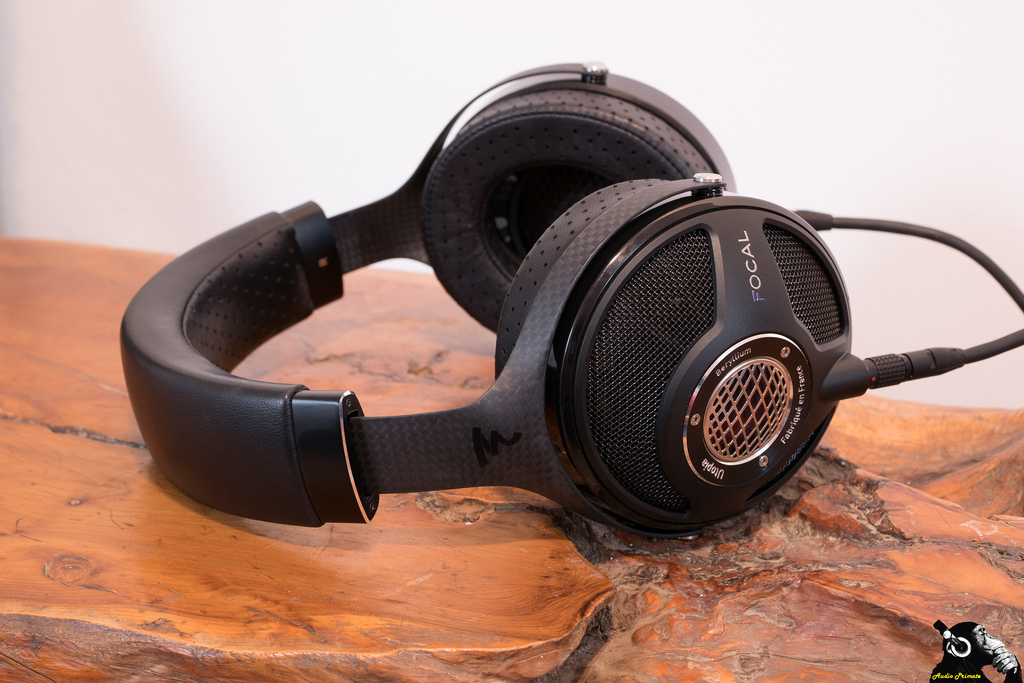

Thanks for your comprehensive review. At last I feel vindicated that the Utopias are not the best headphones in the world ever. I think the Susvara are the best planars I have heard and at any price. The Utopias I thought were great but too much money when you could have the HD800S for half the money and I prefer their compromises to the Utopias compromises.
LikeLike
I’m more in the lightly-modded HD800 camp. The HD800S loses most of what makes the HD800 special. It has lower technical performance and a higher cost. Lambswool mod HD800 is the way to go.
LikeLike